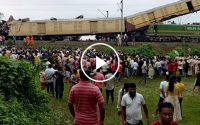Why Does It Take India Six Weeks to Vote?
When Indians start heading to the polls on Friday, it will be just the beginning of a colossal democratic process. Not until June 4, after six weeks of voting, will India know whether its powerful prime minister, Narendra Modi, will remain in office for a third term.
Why does it all take so long? The short answer: India is the world’s most populous nation, with 969 million eligible voters. That’s more than one-tenth of the world’s population, or about four times the number of eligible voters in the next largest democracy, the United States.
The longer answer involves India’s geography, election rules, security apparatus, holidays and electronic voting machines — a complicated choreography for a big, complicated nation.
Mind-Bogglingly Large
India’s first national elections, from 1951 to 1952, lasted over 120 days. In 1977, they took five days. But, generally, they have taken weeks or months, even without primary elections, because of their sheer scale.
The country has a land area of more than a million square miles, with people in megacities, scattered throughout the Himalayas, in the Thar Desert, inside forests and along the Ganges.
India’s laws also state that voters can’t be required to travel more than 2 kilometers, or 1.2 miles, from their home to get to a polling station. To make that possible, 12 million election workers will traverse the country to set up polling stations this year, sometimes by foot, bicycle, helicopter or boat — or even by horse, camel or elephant.
Some of those trips can take days. In 2019, the country’s highest polling station was more than 15,000 feet above sea level in the Spiti Valley of the Himalayas. In 2009, a team of five trekked deep into the Gir Forest in Gujarat, in India’s west, to reach the lone inhabitant of a remote Hindu temple.
“It is an honor, it really is,” the priest, Bharatdas Darshandas, told reporters after the election that year. “It proves how India values its democracy.”
Preserving Order
In the early years of India’s democracy, clashes between supporters of rival parties turned deadly. Candidates were kidnapped. Local police officers, failing to maintain order, were accused of taking sides under pressure from the ruling politicians. So, starting in the 1990s, national paramilitary forces began to be deployed on a large scale in elections.
India is deploying over 300,000 members of its federal security forces to help transport voting machines and maintain peace at voting booths this year. Because they can’t cover the entire nation at once, elections are split into multiple stages. In each stage, the soldiers shift from one region to another.
These safety precautions prolong elections that would otherwise take a few days, said Vikram Singh, the former police chief of India’s largest state, Uttar Pradesh, who had supervised security forces in past elections. But he said voters were safer because of them.
Violence is infrequent at polling stations today. The presence of soldiers there also instills confidence in the election results.
While having multiple stages has prevented violent outbreaks, it has also prompted criticism that it makes the election process take too long. S. Y. Quraishi, a former chief election commissioner, said in an interview that the gaps between the phases had given more time for rumors and disinformation to spread.
Working Around Holidays
When the Election Commission of India schedules votes, it tries to avoid India’s various public holidays and religious festivals. Harvest season, the academic calendar, exam schedules and the weather are also considered.
The careful planning has helped achieve high voter turnout. In 2019, 67 percent of the electorate voted in the national election, the highest participation rate in the country’s history.
One holiday during this election is Mahavir Jayanti, on April 21, one of the most important festivals in Jainism, a religion of some six million people in India. Another is Buddha’s birthday, May 23, when monks will carry sacred relics of Buddha on chariots, and people will decorate their homes with flowers and donate to those in need.
Millions of Machines
Electronic voting machines became a standard in all of India’s national elections in 2004. They have made voting simpler for millions of people, particularly in India’s teeming cities, where the busiest polling stations can serve up to 12,000 people on the voting day.
The machines were built to be more portable and lighter than traditional ballot boxes. But they must be transported to wherever the polling stations are set up. Each machine consists of a “control unit” that tallies and stores votes; “balloting units” with buttons that voters press; and a printer that creates a paper trail.
They also come with special carrying cases that make them easy to pack. Workers follow elaborate safeguards to transport them around the country.
Thanks to these machines, once the voting is over, the counting goes fast.


